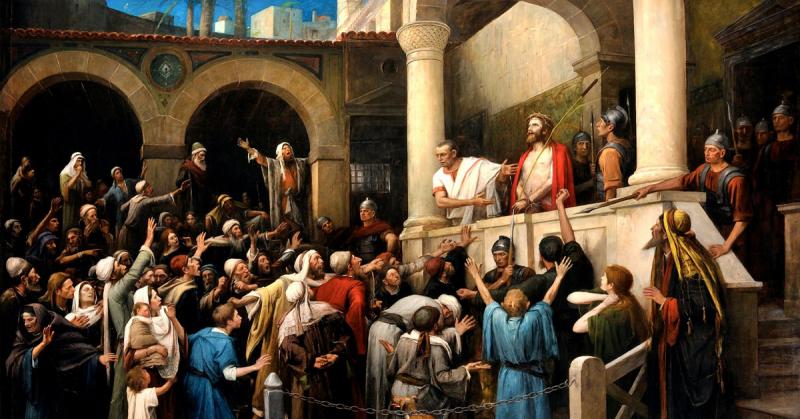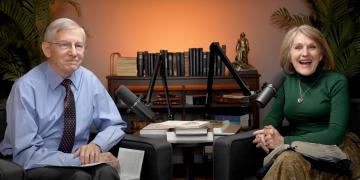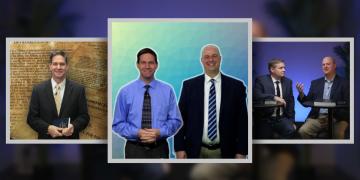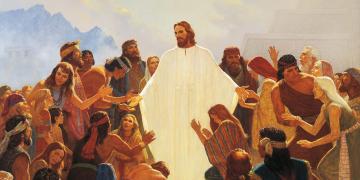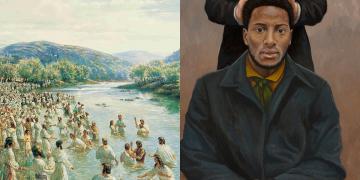You are here
Book of Mormon Central is in the process of migrating to our new Scripture Central website.
We ask for your patience during this transition. Over the coming weeks, all pages of bookofmormoncentral.org will be redirected to their corresponding page on scripturecentral.org, resulting in minimal disruption.
Easter Reflections Day 4: Why Was Jesus Put to Death?
For reflection especially on the day remembered among Christians as “Maundy Thursday,” the day of the Last Supper and when Jesus was arrested, I invite you to consider some of the perspectives that Latter-day Saint insights add to our understanding of the complex question: Why was Jesus killed?
The Need for Humility
Latter-day Saints in particular, but all people as well, know the importance of approaching the subject of the trials and death of Jesus with humility and cautiousness. It will long remain impossible to give a definitive description of all that happened on these final days and in what is called the trial of Jesus. Too little is known today about what was said and done. The laws and procedures that normally should have been followed in Jerusalem at that time remain in many ways obscure. Moreover, Jesus’s case was hardly normal in any legal, political, or spiritual sense. And too little is known about all that happened or did not happen so long ago in order for any modern person to speak with any degree of particularity and certainty about all questions surrounding this case.
As Elder Bruce R. McConkie has wisely said, “There is no divine ipse dixit, no voice from an archangel, and as yet no revealed latter-day account of all that transpired when God’s own Son suffered himself to be judged by men so that he could voluntarily give up his life upon the cross” (Bruce R. McConkie, The Mortal Messiah [Salt Lake City, UT: Bookcraft, 1981], 4:142). All who approach this subject and ponder the heart-wrenching twists and turns in the unfolding of the events leading up to the crucifixion of Jesus should take care to be humble, less dogmatic and certainly less judgmental, concerning this vast subject than people tend to be, both intellectually and spiritually.
Accepting Perplexities
Latter-day Saints can also appreciate the fact that many things make it hard to be definitive about why things happened the way they did in the so-called trial of Jesus. Many things contribute to our perplexities. For example, we would like to know more about the legal rules that were normally followed by the Sanhedrin in Jesus’ day. While much is known about Rabbinic law from the Talmud, the Talmud was written later, from the second to the fifth centuries, by the Pharisees or their successors, and so the Talmud presumably reflects the rules preferred by the late Pharisaic movement. Moreover, the Pharisees were not in control of the Sanhedrin at the time of Jesus. The Sadducees were decidedly in the majority in that body of seventy-one voting members. While we know that the Sadducees and Pharisees differed on a number of points of law, little is known about what the Sadducees believed on many issues, since they and their writings did not survive the destruction of Jerusalem in 70 AD.
We also wonder: Did or did not the Jewish leadership in Jerusalem have the authority to execute anyone at the time of Jesus? All that we are told is that the Chief Priests said to Pilate, “To us is not allowed to kill no one,” as the Greek in John 18:31 somewhat ambiguously reads. But it is not known why they lacked such authorization, or why they would say this to Pilate in this way. Several possibilities come to mind. Perhaps they said this to show deference to Pilate’s ultimate political power and authority. Maybe the Sadducees had reached an understanding with their Roman overlords that they would not take any action—even though it was within their traditional right to do so—without first consulting with Pilate. And perhaps their deference toward Pilate helped them get his ratification for their intended action, even if he did not take over the case entirely, particularly according to John.
And, in any event, it would appear that Jewish people under Roman governance did have some power—or at least took the power on some occasions—to punish and even execute people, as we see in Herod Antipas’s beheading of John the Baptist, or in the attempt to stone Jesus in Nazareth on a local charge of blasphemy in Luke 4, or in the case where people were testing Jesus on the impending stoning of the woman taken in adultery in John 8, or in the execution of Stephen by the Sanhedrin in Acts 7. None of these cases involved Roman authorities. Thus, it is hard to speak with any degree of certitude about the technicalities, especially any alleged illegalities, in the proceedings involving Jesus.
Latter-day Saints can also appreciate the perplexities that arise in earth-shaking moments. Although the reasons behind the death of Jesus and causes of the martyrdom of Joseph and Hyrum Smith were very different, they can be compared. Latter-day Saints can well imagine the turmoil, angst, haste, and commotion surrounding the crucifixion of Jesus, because they relate to the abruptness and confusion involved in the week when Joseph Smith was killed. Unusual situations and cases such as these do not lend themselves to simple explanations.
Parenthetically, some Protestants in the late nineteenth century so exaggerated the alleged illegalities in the execution of Jesus that, instead of increasing sympathy for Jesus or provoking outrage over the way He was treated, that approach actually backfired. Many people in the early twentieth century concluded that if the trial of Jesus was such a fiasco or travesty of justice then maybe it simply had to be a myth and was not historical at all.
Much confusion arises in cases such as this from the array of different accounts that begin circulating about these high-profile and high-stakes cases. Even within the four New Testament Gospels, as we have seen, there are significant differences in what they chose to report. John’s account is very different from the accounts in the synoptic Gospels, and even between the three Synoptics significant legal differences exist. Harmonizing these four Gospel accounts is possible, but in the process one should not ignore their different purposes. Those considerable differences are conveniently displayed in two charts (See Figures 15, 16), first comparing the purposes of each of the Gospels in general, and the second then enumerates distinctive elements in each of their approaches to the trial of Jesus in particular.
Latter-day Saints are usually not troubled by the technical differences between these four New Testament accounts, but some people are. Some Jewish writers, especially, have taken great interest in how these texts are to be interpreted, because the trial of Jesus has been a major cause of antisemitism over the ages. In response to the antisemitism which fueled the Holocaust, Jewish scholars especially in the 1950s and 1960s passionately argued that the Jews had nothing to do with the crucifixion of Jesus and therefore that the Romans must have been completely responsible.
But, in contrast, we as Latter-day Saints find less drastic ways to accept various versions of important scriptural narratives that do not always agree with each other. Not only do we live with, but we are enhanced by, four differing accounts of the Creation (Genesis 1, Genesis 2, Moses 3–5, Abraham 4–5, and the temple endowment), three distinct versions of the Sermon on the Mount (Matthew 5–7, 3 Nephi 12–14, and JST Matthew 5–7), as well as the several accounts of Joseph Smith’s First Vision.

Figure 15 Welch, John W., and John F. Hall. “Purposes and Approaches of the Four Gospels.” Charting the New Testament. Provo, UT: Foundation for Ancient Research and Mormon Studies, 2002, chart 7-3.

Figure 16 Welch, John W., and John F. Hall. “Features in the Four Approaches.” Charting the New Testament. Provo, UT: Foundation for Ancient Research and Mormon Studies, 2002, chart 10-1.
The Perils of Judging Intentions
A problem in many interpersonal relationships is determining another person’s intent. Why did any people involved with the death of Jesus do what they did? What did they intend? What were their motives?
Even today, the greatest challenge in modern courts of law is trying to prove a person’s intent. Scholarly prudence and Christian charity behoove us to withhold casting aspersions. As Jesus asks of us: “Judge not, that ye be not judged” (Matt. 7:1). Having been misunderstood often enough, Latter-day Saints, of all people, should follow a cautious, sensitive approach as we attempt to ferret out the motives of Caiaphas, the Chief Priests, Judas, Herod Antipas, or Pontius Pilate.
Indeed, one may scan the four New Testament Gospels and find precious few explicit indications of what actually motivated any of these people. We may guess, of course, but our guesses are speculations. We may attribute to these people a wide range of political, commercial, social, personal, religious, or legalistic motives; but in most cases the motives that seem the most plausible to us stem, to a large extent, from our own predilections and presentisms.
Thus, for example, some scholars of the 1970s were quite confident that Jesus was executed as some kind of supposed guerrilla warrior, while post-Holocaust Jewish scholars of the 1950s argued that Caiaphas and his temple guards actually took Jesus kindly intending to offer him protective custody and to warn him about the Romans who were out to get him. Such theories and many others like these are mostly in tune with the needs and angsts of the people who propound them.
Latter-day Saints are not immune from such inclinations to ascribe motives. According to Ernest L. Wilkinson in 1966, the cause of the atrocious death of Jesus was none other than the concentration of “legislative, executive and judicial powers … in one unit, …in the Great Sanhedrin,” in which Wilkinson expressly saw the ominous specter of Communism in the midst of the Cold War and the tensions over the Berlin Wall.
More commonly, Latter-day Saints assert that Israel’s judges were motivated by hate. In 1915 the work of James E. Talmage portrayed the Sanhedrists as being galvanized against Jesus by “malignant,” “inherent and undying hatred” (James E. Talmage, Jesus the Christ [Salt Lake City: Deseret Book, 1976], 627, 637). At that time, the Latter-day Saints themselves were battle-weary from repeated attacks and challenges over the previous 80 years, and so that strong language is understandable. But the word hate is actually not found in any of the New Testament narratives of the trial of Jesus per se.
Specifically regarding the motives of those few, particular Jews, Matthew and Mark only say that Pilate could tell “that the chief priests had delivered [Jesus to him] out of envy” (Mark 15:10). But even that is hearsay. And how did anyone know what Pilate was really thinking? In any event, the word envy is not particularly antagonistic. It connotes jealous resentment of someone else’s wisdom or good fortune, but it would usually take more than this common human emotion to amount to a case of lethal hatred.
Some people see Pilate as a weak, incompetent, middle-management functionary who had recently lost his power base in Rome, who was easily intimidated, and who was manipulated by his wife. But this same Pilate, who usually resided in Caesarea (See Figures 17, 18, 19) and may have been cautious in handling Jesus in Jerusalem, still held in his hands the highest legal power of Rome in the area.
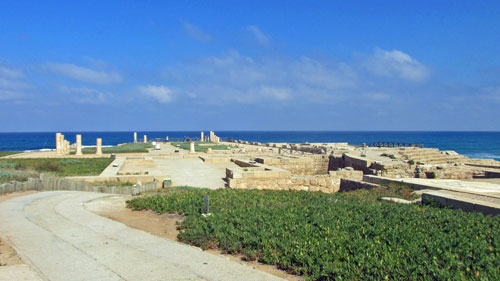
Figure 17 Caesarea Maritima, the usual residence of Pilate. Photo by John W. Welch.
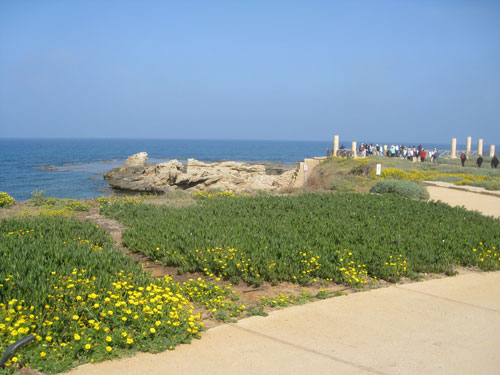
Figure 18 Caesarea Maritima, the usual residence of Pilate. Photo by John W. Welch.
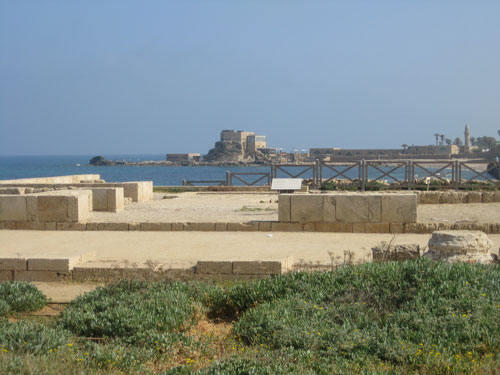
Figure 19 Caesarea Maritima, the usual residence of Pilate. Photo by John W. Welch.
Pilate had not hesitated on other occasions to assert himself, even with military force, against even minor provocations. Having tried in several ways to get the Chief Priests to drop their complaint against Jesus, Pilate saw that nothing was working and “that rather a tumult was made” (Matt. 27:24). Physical violence—a riot—was erupting. When he tried to placate the crowd by giving them Barabbas as a “secure pledge,” Pilate may have acted out of desperation, fear for his own safety, or equally out of hope that the crowd would disperse and leave Jesus and others alone. In fact, in the Joseph Smith Translation, Pilate tells the Jews to leave Jesus alone: “See that ye do nothing unto him” (Matt. 27:20 JST). For additional clarifications of the intentions of Pilate and others in the arrest of Jesus, in his exchange with Pilate, and in events on Calvary, the following chart (See Figure 20) displays ten further additions provided by the Joseph Smith Translation.
Speaking of public antipathy and the lack of tolerance generally, Latter-day Saints readily note that the Gospel of John goes so far as to make it clear that the world (not just Pilate or the Chief Priests) would misunderstand, reject, and hate Jesus, just like the world would also hate all of his true disciples. Jesus said: “But me [the world] hateth, because I testify of it, that the works thereof are evil” (John 7:7); “If the world hate you, ye know that it hated me before it hated you” (John 15:18), for “I am not of the world” (John 17:14). In the cosmic conflict presented in the Gospel of John, this worldly hate of truth is the theological opposite of divine love. That antipathy broadly provides a legal motive for killing Jesus, but these statements more readily apply to all people, both then and now, who reject Jesus and his Gospel in any way, physically as well as spiritually.

Figure 20 Welch, John W., and John F. Hall. “Unique Information or Features in the JST.” Charting the New Testament. Provo, UT: Foundation for Ancient Research and Mormon Studies, 2002, chart 10-2.
The question, Of what crime was Jesus accused?, also has no simple answer. As mentioned in the previous discussion of kakopoios, many other accusations were also heaped upon Jesus. Each accusation would have been made for a different purpose and with a distinct intent and desired outcome. The charges against Jesus included blasphemy, sedition, encouraging tax protesters, and declaring himself a king, but none of these really stuck or would carry the day. And in the Garden of Gethsemane, Jesus asked his arresters why they came after him as if he were a robber. Such outlaws were given no legal rights, let alone a warning or any statement of the charges being brought against them. Even Pilate had to ask, “What is it these men accuse you of?” No one ever gave a straight answer. The Gospels in the end simply say that he was accused of “many things” (Matthew 27:13; Mark 15:3–4; emphasis added).
All this leaves the matter of intent intentionally vague. This should also remind us that precise, modern pleading practices were not followed in ancient courts and that precise assignments of intent in Jesus’ case are perilous.
Just about everything in the situation surrounding the death of Jesus was complicated. It is no wonder that uncertainty was a common reaction of the people to Jesus. Indeed, in reaction to Jesus’ speech in Jerusalem during the Feast of Tabernacles, John says, “There was a division among the people because of him” (John 7:43). “Some said, He is a good man: others said, Nay; but he deceiveth the people. Howbeit no man spake openly of him for fear of the Jews” (John 7:12–13).
A Theater of Fear
This last point in John 7:13, about even the populace being afraid, brings up again further reflection on the pervasive sense of fear on the part of lots of people relating to Jesus. When people get confused, they often become afraid. When they become afraid, they act irrationally. Although the factor of fear is rarely mentioned by New Testament commentators, fear provides the driving emotion that best explains the irregularities, the vagaries, and the urgencies of the trials of Jesus. In understanding the intentions of these actors, fear played a much larger role than people have stopped to realize. And sooner or later, just about everyone in this Easter Week picture is afraid.
People who were sympathetic to Jesus were afraid of the Jewish leaders. The Disciples fled from the scene of the arrest out of great fear. Even the powerful Joseph of Arimathea kept his loyalty to Jesus secret “for fear of the Jews” (John 19:38).
The Chief Priests also were deeply afraid. They worried that if Jesus became too popular, the Romans would come and take away “our place [the holy city, the Temple, or the land] and nation” (John 11:48). But more than fearing Pilate, they feared Jesus. Mark 11:18 clearly states that after Jesus denounced the Temple as a den of robbers, they “sought how they might destroy him: for they feared him.”
Their scheme to destroy him, however, seems to have gone quickly awry. After he was arrested, Jesus was treated like a hot potato, being passed quickly from one hand to another—hands “of frightened subordinates whose plans had gone astray,” as Dallin H. Oaks, then a law professor, wrote in 1969—with no one wanting to take the rap for either his death or his release.
They were not the only ones who were frightened of Jesus. When Pilate heard the words “he has made himself the son of God,” his reaction was fear. John states that Pilate “was the more afraid” (John 19:8). Even Herod Antipas was said to fear the crowd.
Moreover, Golgotha, that scene of gruesome death, became a theater of fear. The centurion and those with him, when they felt the earth quake, “feared exceedingly” about what they had done. Anxiety and phobias are everywhere in this story—far more than people usually think.
And it bears recalling, Latter-day Saints can relate. They are not unacquainted with fear, either historically or in today’s highly charged atmosphere. The book of Doctrine & Covenants speaks often of the realities of fearful situations (D&C 1:7; 63:6), saying that fear will seize upon the wicked (45:74; 63:16). The Lord admonishes people to fear and revere only him, and that because of fear, blessings will be lost (67:3), especially when one fears public pressures or what society might do (60:2). Knowing absolutely the reality and the magnitude of what was at stake with the trial and death of Jesus, Latter-day Saints can appreciate poignantly the level of fear that surrounded all that happened as the crucifixion of Jesus drew close and then to a close.
A Fear of Power
Although the followers of Jesus accepted his miracles as manifestations of divine power, those who did not believe that Jesus was the Son of God found His wondrous works fundamentally disturbing. Indeed, a common reaction to all of the miracles of Jesus was fear, for if Jesus worked not by the power of God, he must have been possessed by “Beelzebub, and by the prince of the devils casteth he out devils” (Mark 3:22).
In Matthew 9 we read that Jesus healed a man who had been paralyzed by some kind of stroke. The King James Version of the Bible says that when the people saw this “they marveled.” But the original Greek says that “they were afraid” (Matt. 9:8). When the multitude saw Jesus raise the son of the widow in Nain and heard the young man speak, their reaction again was sheer terror: “And there came a fear on all,” as Luke 7:16 reads. Fear of the extraordinary powers of Jesus, which nonbelievers saw as coming from the realm of the occult, explains much of what transpired in his trials.
But even the faithful are struck with awe when they find themselves in the personal presence of a divine being. And indeed, personal manifestations of miracles or the glorious appearance of supernatural beings would probably evoke fear in most of us. Joseph Smith’s first reaction, as he felt the power of darkness nearly overwhelming him and then saw the burning pillar of fiery light descend upon him in his First Vision, was fear.
Likewise, the first words of an angel to Zacharias were “Fear not.” Mary also was told by Gabriel, “Fear not” (Luke 1:30). As were the shepherds in the fields as well. Even the apostles ran from the angel at the tomb, trembling, “for they were afraid” (Mark 16:8). When those disciples had assembled, the resurrected Lord’s first words to them needed to be, “Be not afraid” (Matthew 28:10).
And then, imagine the anxieties involved in trying to arrest Jesus. The Chief Priests could not have undertaken this venture lightly and must have steeled themselves against the unexpected. Jesus was known to have amazing powers. In his law-giving, Jesus had presented himself as a new Moses, and the Chief Priests were well aware of what Moses had done to Pharaoh and his army. Some of the Chief Priests had been involved in the attempt to stone Jesus when he “hid himself . . . , going right through the midst of them,” and escaped undetected (John 8:59). With Jesus known as something of an escape artist, people had their hands full planning to take him at night and at the height of his power. It is no wonder they needed to enlist the assistance of Judas, one of his closest followers.
Thus, they may well have wondered, if Jesus had the power to command loaves and fishes, to still the waves, to wither fig trees, and to order evil spirits, what powers might he use in defense of himself and his apostles? The raising of Lazarus—which had occurred just a short time earlier and in Bethany just on the other side of the Mount of Olives east of Jerusalem—had brought Jesus’ powers close to the Holy City. It was then that the Chief Priests and Pharisees gathered in a council and said, “What do we [do]? for this man doeth many miracles” (John 11:47). As discussed previously in these Reflections, that disclosure confirms the deep root of their concerns, that Jesus was a miracle worker. If his wonder workings were not miracles from God, the only other choice was that Jesus had to be some kind of trickster. Coupling these powers with what they considered to be his curse upon the Temple itself (Mark 14:58) yields a potent formula for trepidation and the need to strike quickly.
Even at his arrest, Jesus continued to call upon his miraculous powers. Jesus told Peter, “Thinkest thou that I cannot now pray to my Father, and he shall presently give me more than twelve legions of angels?” (Matthew 26:53); and when Peter cut off the ear of the high priest’s servant, Jesus “touched his ear, and healed him” (Luke 22:51). Anyone in the group of arresters hearing or seeing these things must have been stunned. Moving forward must not have been easy for them.
Supernatural factors continue to play a dominant role up to the end of Jesus’ life. People witnessing his crucifixion wondered if Jesus could save himself; they waited to see if the miracle-working Elijah would rescue him from the cross. Although that did not happen, the rocks split apart, graves opened, and holy spirits came forth out of the ground after Jesus’s death (Matthew 27:51–53).
Behind everything lurked a strong, albeit misplaced, undercurrent of fear of unseen powers. For Latter-day Saints, this reaction to the miracles of Jesus comes as no surprise. In a significant revelation found in the Book of Mormon, an angel announced to King Benjamin that Jesus Christ would go about “working mighty miracles, such as healing the sick, raising the dead, [and] cast[ing] out . . . evil spirits” (Mosiah 3:5); but “even after all this they shall consider him a man, and say that he hath a devil, and shall scourge him, and shall crucify him” (Mosiah 3:9). From the Book of Mormon, one may well see his extraordinary power as the proximate or precipitating cause of the death of Jesus.
It was not so much that Jesus posed some kind of political threat, and it was not that some people disagreed with his doctrines, but rather that certain key people considered him to be of the devil. Latter-day Saints can relate. In 1879 an article appeared in the Latter-day Saints’ Millennial Star comparing the death of Jesus to that of the Prophet Joseph Smith. In both cases, the “chief crime was that he obtained revelations from heaven.” In both cases, divine power had been mistaken for some kind of unacceptable contacts with the supernatural.
Political Nervousness
The fear of power united the Pharisees, the Chief Priests, and Pilate. Otherwise political enemies, they were brought together by their mutual, political nervousness.
Indeed, the Pharisees were nervous to the bitter end that Jesus, whom they called a “deceiver” or a “trickster” (planos), would indeed rise after three days, as he had prophesied. They worried that this, his last “trick” (planē), would be worse than his first (Matt. 27:64). The word planos, in other early texts such as the Testaments of the Twelve Patriarchs and the Sybilline Oracles, can indeed mean especially one who deceives through evil powers or spirits and thereby fools even the elect and powerful through nature miracles, including churning up the sea or raising the dead. Obviously, being a planos could raise serious political as well as religious concerns.
Expanding on the previous discussion of the word kakopoios, concerns about numinous powers could easily become a matter of public concern. While certain forms of divining were not necessarily problematical under Jewish or Roman law—for example, people such as Simon the Magician (see Acts 8:9) and Theudas, another wonder worker (see Acts 5:36), seem to have walked the streets freely—when incantations, spells, or curses were used for improper purposes, political leaders become nervous, and the users of such powers could be severely punished (see, for example, the case of the sorcerer, Bar-Jesus, before the Roman governor Sergius Paulus in Cyprus, in Acts 13:6-11).
These extraordinary powers could destabilize the ruling order. Such behavior could be punished by death under Jewish law (see Lev. 20:27). Deuteronomy 13:1 made it an offense worthy of death to use signs or miracles to pervert or lead people into apostasy, as Caiaphas in John 11 had already determined. Roman law also outlawed certain forms of spell-casting or divination and made them punishable by death. In A.D. 11, Augustus Caesar himself issued an edict forbidding people from prophesying about a person’s death. Such conduct had apparently become a serious political and social problem in the Roman world. The main thrust of Augustus’s decree was to expand the law of maiestas (treason), which had long punished people who harmed the state by actions. Now it was made to include treasonous divination, especially augury directed against the imperial family. This “empire-wide imperial legislation circumscribed astrological and other divinatory activities everywhere,” and we know of about one hundred trials for maiestas coming from the time of Tiberius alone.
This is not to say that Jesus was crucified for predicting the death of Tiberius Caesar or anyone else, but it may give another reason why the Chief Priests thought they could get Pilate to take action against Jesus. If Jesus—who had been born under an unusual star and visited as an infant by magi (astrologers or sign-readers) from the east—spoke evil predictions against the Temple and against the survival of the Jewish nation, and even prophesied about his own death, perhaps his next target would be to cast spells on Caesar. If that were to happen, letting Jesus go would certainly make Pilate no friend of Caesar. As their final argument, the Chief Priests asserted that anyone who made himself a king necessarily “speaketh against Caesar” (John 19:12). All this looks like an effort to make allegations of maiestas or high treason.
And it is ironically painful that the main charge on which the Prophet Joseph Smith was held in Liberty Jail in the winter of 1838–1839 and in the Carthage Jail on June 27, 1844, was also a trumped up charge of treason.
Later Roman law would even specify that the punishment for enchanters or spellbinders was crucifixion. That was the same punishment given to bandits, brigands, traitors, rebellious slaves, and others whose deviance threatened the government’s power and the Pax Romana. This underlying concern disrupting the public order would especially explain the puzzles of crucifixion and the lack of legal formalities in the trials of Jesus after his arrest.
And since the publication of the Temple Scroll from the Dead Sea in the 1970s, scholars now acknowledge that hanging on a tree (or crucifixion) could serve not only as a Roman mode of execution but as a Jewish remedy as well. In a notorious case a century before the time of Jesus, 80 witches were hung (or crucified) in Ashkelon without proper trials, because the Jewish court saw the matter as a state emergency.
Ultimately, of course, Pilate found no legal cause of action here, because Jesus claimed that his kingdom had nothing to do with Caesar’s world, and Pilate was satisfied that the man from Nazareth had not broken any Roman law. But Pilate was still worried enough by the unsettling threats of widespread riot or tumult that he was willing to take some action to try to control the situation and to go along with Jesus’s accusers.
To be concluded . . .
Further Reading
An earlier version of these reflections was published as John W. Welch, “Latter-day Saint Reflections on the Trial and Death of Jesus,” Clark Memorandum (Fall 2000): 2–13.
Subscribe
Get the latest updates on Book of Mormon topics and research for free


